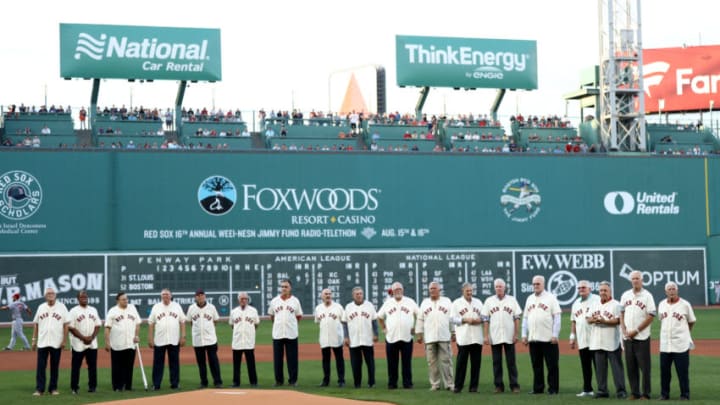The Boston Red Sox have honored the 1967 team and that is significant for Red Sox history. That year became the catalyst for a team that continues to be a premier franchise in baseball.
On August 17, the Boston Red Sox celebrated and honored the 1967 team that catapulted from ninth place the previous season to a dramatic last day of the season win to get to the World Series.
The 1967 season was a four-team race until the last weekend when it became narrowed even further. The 1967 team was youthful, with a 27-year-old Carl Yastrzemski as the elder veteran among the position player starters.
The 1967 club is generally credited with arousing Red Sox fans out two decades of hibernation and creating a burnt-over district at Fenway Park – a baseball Great Awakening that has resonated to the present. From 1952 to 1966, the Red Sox sporadically drew in excess (barely) of one million fans. This is relevant since the Braves had departed prior to the 1953 season, leaving the Red Sox with no regional competition for baseball fandom.
More from BoSox Injection
- Red Sox Nation deserves far more from Fenway Sports Group
- Bizarre trade deadline comes back to haunt Red Sox after Nathan Eovaldi departure
- Red Sox’ Moneyball-style offseason continues with Corey Kluber contract
- Rich Hill’s Red Sox departure puts him within striking distance of unique MLB record
- Red Sox offseason takes another nasty hit with Nathan Eovaldi departure
The Red Sox in that miserable time span that coincides with my baseball awakening were simply a date on the schedule for most teams – even the New York Yankees. Fenway Park was an outdated dump even by measurements of that day. The team was a poor product that became a haven for under-performing prospects, aging veterans, and others who simply went through the motions. But – to me – the real turning point was not 1967, but 1964.
Tony Conigliaro was something special – very special. At 19-years-old the Boston area native captivated the region with special emphasis on the Italian-American community. Tony C. was a PR dream with marquee looks, brashness and the ability to captivate with the big plus in baseball – the home run.
Tony C. was the first in an influx of new talent that suddenly materialized like a water hole in the Sahara to fill the thirst for anything positive after years of bitter disappointment. George Scott, Reggie Smith, Dalton Jones, Joe Foy, Jim Lonborg, Mike Andrews and a talented supporting cast. The team caught fire and caught the imagination. But that 1964 year started a spark that created a fire.
Analogies are certainly not my forte, but I saw a commercial regarding how the Shingles Virus lays dormant for years and that was the Red Sox fans in 1967. Just waiting for an opportunity. Attendance doubled and has never looked back. Even in the wretched days of management infighting and the Yawkey Trust the team remained competitive. No 20-year drought.
I had been long-suffering despite being only 23-years-old. In those depressing years the only time I could have a grasp of faith was in 1959 when the Red Sox defeated the perennial champion New York Yankees in five straight at Fenway to keep them well behind the eventual champions – the other Sox.
More from Red Sox History
- Two notable Red Sox anniversaries highlight current organizational failures
- Contemporary Era Committee doesn’t elect any former Red Sox to Hall of Fame
- Johnny Damon calls Red Sox out, reveals hilarious way he skirted Yankees’ grooming policy
- Remembering the best Red Sox Thanksgiving ever
- Red Sox World Series legends headline 2023 Hall of Fame ballot
Occasionally it all came down to not how much the team accomplished, but how individuals would do. Somewhat prophetic since the team was considered just that – a group of individuals – “25 cabs for 25 players.” So I could cheer on Pete Runnels getting a batting title or Jackie Jensen – a true five tool player – winning an MVP Award. The mindset it created was how your favorites did and not the team. The 1967 squad ended all that.
In 1967, I – like several million others – went to each World Series game. How I got tickets was interesting, as I had broken a wrist in a motorcycle accident and was out of work for September and October. Prior to that, I had still gone to as many games as possible, so when mail in requests to be selected for tickets I tossed all my ticket stubs in an envelope and was rewarded by someone who was impressed.
The one item that stood out was the bunting around the park. I had seen this in the 1961 All-Star Game, but this was different – far more personal. This was unique and something only witnessed on television when other teams made the grade. Unfortunately, the series – great as it may have been – ended with St. Louis and the great Bob Gibson victorious.
Next: Dave Dombrowski goes from sinner to saint
The core of that team disintegrated for a variety of reasons, but a few key players remained and became integrated into the remarkable teams of the mid to late 1970’s. By then Red Sox Nation was founded and we were becoming accustomed to success.
